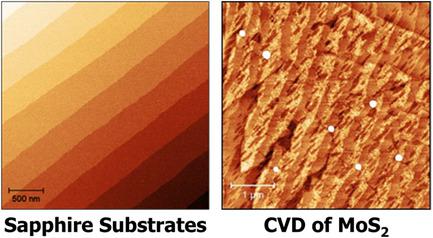当前位置:
X-MOL 学术
›
Phys. Status Solidi A
›
论文详情
Our official English website, www.x-mol.net, welcomes your feedback! (Note: you will need to create a separate account there.)
Directing the Morphology of Chemical Vapor Deposition‐Grown MoS2 on Sapphire by Crystal Plane Selection
Physica Status Solidi (A) - Applications and Materials Science ( IF 2 ) Pub Date : 2020-05-15 , DOI: 10.1002/pssa.202000073 Lisanne Peters 1, 2 , Cormac Ó Coileáin 1, 2 , Patryk Dluzynski 1 , Rita Siris 3 , Georg S. Duesberg 1, 2, 3 , Niall McEvoy 1, 2
Physica Status Solidi (A) - Applications and Materials Science ( IF 2 ) Pub Date : 2020-05-15 , DOI: 10.1002/pssa.202000073 Lisanne Peters 1, 2 , Cormac Ó Coileáin 1, 2 , Patryk Dluzynski 1 , Rita Siris 3 , Georg S. Duesberg 1, 2, 3 , Niall McEvoy 1, 2
Affiliation

|
Crystalline substrates are known to function as a template for the growth of Van der Waals materials. Van der Waals materials, specifically transition metal dichalcogenides, have gained attention in the past decade due to their interesting chemical and physical properties, as well as the potential they hold for applications, particularly in the field of (opto‐)electronics. The crystalline quality of these materials can be improved by epitaxial growth. Herein, the influence substrate selection has on ordering the growth of MoS2 is examined. Specifically, the impact sapphire crystal orientation has on the morphology and alignment of MoS2 grown by chemical vapor deposition is investigated. C‐plane , R‐plane , A‐plane , and M‐plane Al2O3 substrates, annealed at high temperature in air, are used as templates for MoS2 growth. Comparative analysis, including photoluminescence spectroscopy, Raman spectroscopy, and atomic force microscopy, reveals distinct characteristics and growth modes depending on the growth substrate used. It is found that aligned growth of MoS2 is influenced by the terrace size, atomic steps, and substrate interaction with the MoS2. Aligned growth occurs on both R‐ and M‐plane sapphire. For A‐plane sapphire, the MoS2 flakes are variable in size and thickness. The weakest substrate interaction is observed for growth on C‐plane sapphire, which consists of randomly oriented flakes.
中文翻译:

通过晶面选择指导蓝宝石上化学气相沉积生长的MoS2的形态
已知结晶基质可作为范德华材料生长的模板。范德华材料,特别是过渡金属二卤化钨,由于其有趣的化学和物理特性以及它们在应用中的潜力,特别是在(光电)电子领域,在过去十年中受到了关注。这些材料的晶体质量可以通过外延生长来改善。在此,研究基板选择对MoS 2的生长有序的影响。具体地,研究了冲击蓝宝石晶体取向对通过化学气相沉积生长的MoS 2的形态和取向的影响。C平面,R平面 , 一架飞机 和M平面 在空气中高温退火的Al 2 O 3衬底用作MoS 2生长的模板。比较分析(包括光致发光光谱,拉曼光谱和原子力显微镜)揭示了不同的特性和生长模式,具体取决于所使用的生长基质。已发现,MoS 2的取向生长受平台尺寸,原子步长以及与MoS 2的底物相互作用的影响。在R平面和M平面蓝宝石上均发生对齐的生长。对于A面蓝宝石,MoS 2薄片的大小和厚度是可变的。在C平面蓝宝石上观察到最弱的底物相互作用,该蓝宝石由随机取向的薄片组成。
更新日期:2020-05-15
中文翻译:

通过晶面选择指导蓝宝石上化学气相沉积生长的MoS2的形态
已知结晶基质可作为范德华材料生长的模板。范德华材料,特别是过渡金属二卤化钨,由于其有趣的化学和物理特性以及它们在应用中的潜力,特别是在(光电)电子领域,在过去十年中受到了关注。这些材料的晶体质量可以通过外延生长来改善。在此,研究基板选择对MoS 2的生长有序的影响。具体地,研究了冲击蓝宝石晶体取向对通过化学气相沉积生长的MoS 2的形态和取向的影响。C平面,R平面 , 一架飞机 和M平面 在空气中高温退火的Al 2 O 3衬底用作MoS 2生长的模板。比较分析(包括光致发光光谱,拉曼光谱和原子力显微镜)揭示了不同的特性和生长模式,具体取决于所使用的生长基质。已发现,MoS 2的取向生长受平台尺寸,原子步长以及与MoS 2的底物相互作用的影响。在R平面和M平面蓝宝石上均发生对齐的生长。对于A面蓝宝石,MoS 2薄片的大小和厚度是可变的。在C平面蓝宝石上观察到最弱的底物相互作用,该蓝宝石由随机取向的薄片组成。



























 京公网安备 11010802027423号
京公网安备 11010802027423号